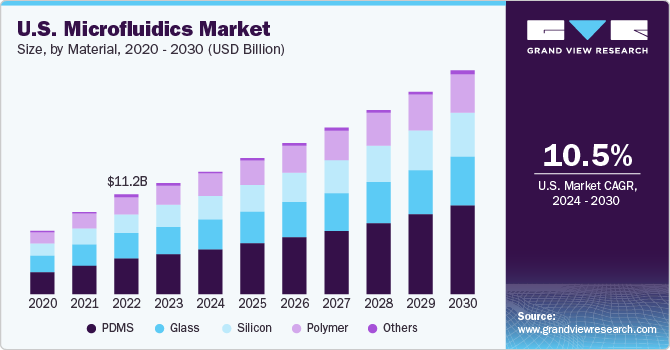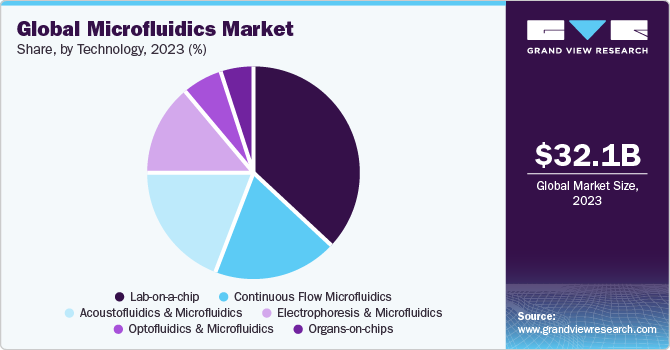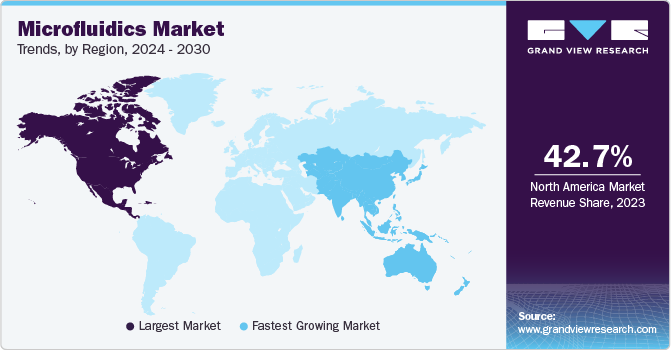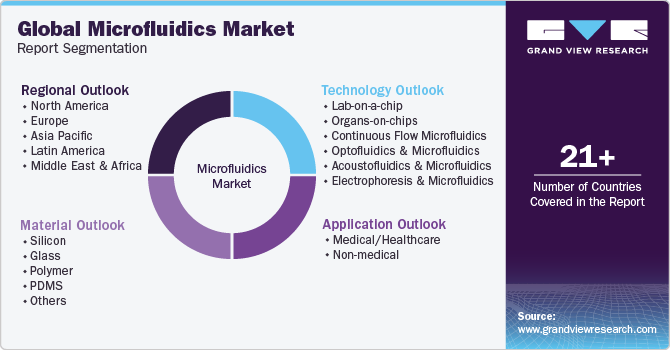- Home
- »
- Biotechnology
- »
-
Microfluidics Market Size And Share, Industry Report, 2030GVR Report cover
![Microfluidics Market Size, Share & Trends Report]()
Microfluidics Market Size, Share & Trends Analysis Report By Application (Medical/Healthcare, Non-Medical), By Material (Silicon, Glass), By Technology, By Region, And Segment Forecasts, 2024 - 2030
- Report ID: GVR-1-68038-056-9
- Number of Report Pages: 135
- Format: PDF, Horizon Databook
- Historical Range: 2018 - 2022
- Forecast Period: 2024 - 2030
- Industry: Healthcare
Microfluidics Market Size & Trends
The global microfluidics market size was estimated at USD 32.15 billion in 2023 and is expected to grow at a compound annual growth rate (CAGR) of 12.22% from 2024 to 2030. The increasing penetration of microfluidics devices in various fields of research and diagnosis is expected to drive market growth. For instance, there has been an improvement in the number of microfluidic devices applicable to ophthalmological conditions over the past decade. Microfluidic approaches have been effectively used to determine glucose levels, detect infection, diagnose dry eye disease, and assess levels of vascular endothelium growth factor. Such applications are expected to positively affect the market growth in the coming years.

An exponential rise in COVID-19 cases globally boosted the demand for microfluidics tools. Many approved tests are based on PCR, making it a preferred technique for COVID-19 diagnosis. To combat the rising cases of COVID-19 globally, several manufacturers have introduced products and ramped up their production to address the growing demand for IVD tests. When coupled with microfluidics, the PCR technique can be accelerated, which, in turn, provides faster test results (from approximately 1 hour to less than 10 minutes) with high accuracy.
For instance, BeforCure, a spin-off company from Elvesys, developed an ultra-fast PCR-on-chip system for the detection of the virus. This product is based on Fastgen technology and leverages the advantages of microfluidics to deliver test results in less than 30 minutes. Furthermore, various studies are being conducted to evaluate the use of microfluidics in COVID-19 detection by PCR technique. A study was published in June 2021 by researchers in China that demonstrated the use of the latest rapid microfluidic PCR. It concluded that rapid PCR can be achieved with the use of emerging state-of-the-art microfluidics for SARS-CoV-2 detection.
The major advantage of microfluidics devices is their ability to analyze small volumes of samples. This reduces the amount of reagent waste and helps preserve samples that are difficult to produce. The introduction of microfluidics devices has driven the demand for low-volume sample devices. A surge in research activities undertaken by analytical and clinical researchers has also driven the demand for microfluidics devices. The conventional method of genome analysis requires decoding the entire DNA, thus adding to the cost of analysis and time. Microfluidics devices need a very small volume of samples for data interpretation. The application of microfluidics has allowed conventional laboratory procedures to be miniaturized onto a lab-on-a-chip.
The point-of-care diagnostics introduced by numerous market players led to early disease diagnosis and reduced hospital visits. With improved technologies, market players now distinguish their products using minimally invasive features along with accuracy and speed. Microfluidics has thus made its mark in the IVD market. Moreover, market players, such as Abbott, Roche, and Danaher, have already incorporated microfluidics technology in their existing diagnostic devices. With advancements in technology, digital microfluidics is being explored by several key players. In August 2022, HORIBA announced a collaboration with SigTuple to speed up the deployment of its AI100, an AI-assisted digital pathology solution, in the Indian subcontinent. SigTuple combined AI, robotics, microfluidics, and cloud computing to develop smart diagnostic solutions to make quality healthcare delivery accessible and affordable.
With the increasing penetration of microfluidics devices in various fields of research and diagnosis, advanced technologies are introduced by industry players to grab a potential market share. Many companies have their devices under trial and are anticipated for commercialization. For instance, in January 2022, BIOLASE, Inc., and EdgeEndo received FDA 510(k) clearance for the EdgePRO system, intended for effective disinfection and cleaning alternatives within root canal processes. The laser-aided microfluidic irrigation tool offers an enhanced solution to existing disinfection and cleaning techniques, without interrupting process workflow or adding significant cost on a per-procedure basis.
In March 2021, the Loschmidt laboratories team, together with partners from ETH Zurich, developed a microfluidic platform for an effective and rapid investigation of enzymes and their properties. The novel platform was already being used for developing new thrombolytics to treat stroke and study bioluminescent enzyme evolution. Besides, in November 2019, Panasonic Corporation and IMT jointly created a technology for the mass production of microfluidic devices utilizing glass molding. Compared to the conventional glass etching technique, this technology uses low-cost and highly accurate mass production. These devices can be used for analysis and sensing in biological, environmental, and medical applications, thus likely to drive the growth of the market in the forecast period.
Technology Insights
Based on technology, the lab-on-a-chip segment dominated the market in 2023 and is expected to reveal a CAGR of 11.06% during the forecast period. The lab-on-chip allows rapid sequencing of DNA probes. As DNA amplification applying the PCR technique depends on thermal cycles, the lab-on-chip conducts high-speed thermal shifts at the microscale level. Elveflow offers the fastest qPCR system—Fastgene system, that detects bacteria and viruses within 7 minutes. Moreover, nanopore technologies hold great potential in facilitating rapid genome sequencing of DNA probes than actual lab-on-a-chip using an array technique. Similarly, these systems hold lucrative opportunities for immunoassays that can be performed within 10 seconds instead of 10 minutes when done by macroscopic technologies. Therefore, operations performed using labs-on-a-chip have greater potential for ultra-fast virus and bacteria detection.

The lab-on-a-chip research has recently shown potential in cell biology. These systems validate the capability to regulate cells at the single-cell level while dealing with a huge volume of cells within a short time. Opto Reader, a fast-optical detector provided by Elveflow helps in the detection and isolation of cells. These systems are also used in stem cell differentiation, micro patch-clamp, cell sorting, and high-speed flow cytometry.
The organs-on-chips segment is anticipated to witness a considerable growth rate of 17.21% from 2024-2030. These models play a major role in drug discovery and development. Since 2012, the National Center for Advancing Translational Science (NCATS) through its Tissue Chip for Drug Screening initiative along with the FDA and other National Institute of Health (NIH) centers and institutes focuses on the drug discovery process. This is possible with the creation of human tissue chips that deliver accurate representations of human organs. NCATS aims to reduce significant challenges between research discovery and clinical trials as well as ensure focus on high-need cures. For instance, in March 2022, NCATS initiated a collaboration with the U.S. FDA and other NIH institutes to design human tissue chips that precisely model the structure and function of human organs, including the heart, liver, and lungs. This initiative was expected to help predict drug safety in humans more effectively and rapidly.
Regional Insights
North America dominated the market with a revenue share of 42.69% in 2023 and is projected to exhibit a CAGR of 10.57% during the forecast period. An increase in research funding from government organizations and industries is the major factor driving the market growth. The demand for microfluidics devices in the research and diagnostics field has propelled the industry-academia collaboration to accelerate the commercialization of lab-built devices.

For instance, in July 2020, Fluidigm Corporation executed a letter contract with the National Institute of Biomedical Imaging and Bioengineering, and the National Institutes of Health for the Rapid Acceleration of Diagnostics program. The venture, with an overall proposed budget of up to USD 37 million, intended to expand the output capabilities and production capacity for COVID-19 testing with microfluidics technology from Fluidigm. In addition, the program fast-tracked commercialization and development of groundbreaking technologies to significantly increase testing capacity for SARS-CoV-2 in the U.S.
Asia Pacific is expected to expand at a high growth rate of 16.38% during the forecast period owing to sophisticated research infrastructure, a developing economy, and affordable labor. International players are keen on investing in the untapped APAC microfluidics industry. The market for diagnostic tests based on microfluidic is majorly dominated by foreign players. However, key players in the region are proposing innovative and interesting solutions in terms of performance, and more significantly in terms of price, which can allow them to boost their market share in the coming years.
The government in China has set up a strategic plan to broadly enhance the local industry and make the country an important player. This plan, named Made in China 2025, incorporates a focus on medical devices and pharmaceuticals. As a vital tool for life sciences and diagnostics applications, microfluidic technology is expected to benefit the money spent in the perspective of this strategic plan.
Market Dynamics
Microfluidics devices offer a significant advantage due to their capability to analyze small sample volumes, resulting in reduced reagent waste and the preservation of challenging-to-produce samples. The emergence of microfluidics devices has spurred the demand for low-volume sample analysis. The increasing engagement in research activities by analytical and clinical researchers has further propelled the adoption of microfluidics devices. Traditional genome analysis methods entail decoding the entire DNA, incurring higher costs and time. In contrast, microfluidics devices require minimal sample volumes for data interpretation. The integration of microfluidics has enabled the miniaturization of conventional laboratory procedures into lab-on-a-chip systems. Notably, recent product launches featuring low-volume analysis capabilities have stimulated market growth. For example, in July 2023, Biotech Fluidics introduced innovative low-volume online degassing modules tailored for nano and microfluidic systems, applicable in drug screening, nucleic acid sequencing, diagnostics, and tissue culture.
Over the past decade, the availability of microfluidics devices suitable for evaluating ophthalmological conditions has increased. These microfluidic approaches have proven effective in determining glucose levels, detecting infections, diagnosing dry eye disease, and assessing vascular endothelium growth factor levels. Some recent microfluidics technologies have leveraged contact lens technology to provide theranostic and diagnostic approaches. For instance, Guan et al. developed a contact lens-on-a-chip serving as a diagnostic tool for precision medicine, enabling the quantification of microbial and protein bioburden using a small volume of tear fluid. Additionally, researchers from Imperial College London devised a desorption electrospray ionization mass spectrometry method as a potential point-of-care diagnostic approach for the rapid analysis of mucosal fluid. Noteworthy developments also include small-volume sample analysis of nasal secretions to examine infectious and allergic diseases.
Application Insights
Based on application, the medical segment held the highest revenue share of the market in 2023 and is expected to exhibit a CAGR of 12.56% from 2024-2030. Microfluidics is considered a significant technology in biological analysis, chemical synthesis, and information technology. The miniaturization of conventional laboratory equipment and technologies through microfluidics has led to several advancements including minimal usage of reagents and maximum information derived from small sample sizes, short and simple assay protocols, improved parallel processing of samples and screening approaches, and accurate spatiotemporal control of cell microenvironments.
Microfluidics has not only been proven beneficial in biological practices but also in several medical and pharmaceutical applications, including the diagnosis of infectious diseases, the treatment of cancer, and the fabrication of functional living tissues and artificial organs. For instance, in August 2022, associates at the School of Electrical and Computer Engineering, Atlanta, U.S., developed the Cluster-Well chip, which leveraged the precision of microfluidic chips to detect metastatic cancer and enable quick and easy treatment of cancer.
Researchers are focused on developing integrated microfluidics devices capable of performing high-precision PCR. Furthermore, PCR carried out on a microfluidic chip offers benefits such as speed, parallelization, and sensitivity. For instance, in October 2022, X9 Real-Time PCR System was launched by Standard BioTools, Inc., using microfluidics technology to provide a flexible and productive high-capacity genomics platform. Moreover, microfluidic PCR devices offer the capability to automate the preparation of PCR reaction mix, which, in turn, minimizes the risk of false positives and contamination by human error.
Material Insights
Based on material, the polydimethylsiloxane (PDMS) segment held the highest market share in 2023 and is expected to grow at a CAGR of 13.59% from 2024-2030. PDMS is a widely used polymer in microfluidics owing to the several advantages offered by the material. Some of the advantages of PDMS are nontoxicity, robustness, optical transparency, permeability to gas and oxygen, biocompatibility, elastomeric features, low cost, and complex designs of microfluidic devices by stacking multiple layers.
The rapid adoption of microfluidics-enabled LOC devices has created several growth opportunities for PDMS usage in the experimental microfluidics space. As PDMS is known to exhibit biocompatibility, permeability, and low levels of autofluorescence, the material is expected to gain significant traction in several applications of biotechnology and biomedical engineering in the forecast period.
However, these polymers are hydrophobic, which makes microchannels difficult to operate in aqueous solutions as hydrophobic analytes are adsorbed onto the surface of PDMS, which tends to hinder the analysis. Such factors may limit the adoption of PDMS materials.
Key Companies & Market Share Insights
Key players in the market are implementing various strategies including partnerships through mergers and acquisitions, geographical expansion, and strategic collaborations to expand their market presence.
-
For instance,in September 2019, SCHOTT AG enrolled a purchase contract to acquire the microfluidic company MINIFAB Pty Ltd. This initiative was expected to permit both partners to substantially boost their product range in the diagnostics market.
-
In October 2022, Standard BioTools, Inc. launched the X9 Real-time PCR system, a genomics instrument based on a microfluidics platform that offers high efficiency and data output in a single run. This launch was expected to boost the company’s product portfolio.
-
In February 2023, Amar Equipment, an India-based company, launched NanoMake, a microfluidics-based device. The launch was to boost the preclinical research for mRNA vaccines for COVID-19. Such product launches are expected to facilitate market growth.
Key Microfluidics Companies:
- Illumina, Inc.
- F. Hoffmann-La Roche Ltd
- PerkinElmer, Inc.
- Agilent Technologies, Inc.
- Bio-Rad Laboratories, Inc.
- Danaher Corporation
- Abbott
- Thermo Fisher Scientific
- Standard BioTools
Microfluidics Market Report Scope
Report Attribute
Details
Market size value in 2024
USD 36.00 billion
Revenue forecast in 2030
USD 71.90 billion
Growth rate
CAGR of 12.22% from 2024 to 2030
Base year for estimation
2023
Historical data
2018 - 2022
Forecast period
2024 - 2030
Quantitative units
Revenue in USD million /billion and CAGR from 2024 to 2030
Report coverage
Revenue forecast, company ranking, competitive landscape, growth factors, and trends
Segments covered
Technology, material, application, region
Regional scope
North America; Europe; Asia Pacific; Latin America; MEA
Country scope
U.S.; Canada; UK; Germany; France; Italy; Spain; Denmark; Sweden; Norway; Japan; China; India; Australia; Thailand; South Korea; Brazil; Mexico; Argentina; South Africa; Saudi Arabia; UAE; Kuwait
Key companies profiled
Illumina, Inc.; F. Hoffmann-La Roche Ltd; PerkinElmer, Inc; Agilent Technologies, Inc.; Bio-Rad Laboratories, Inc.; Danaher Corporation; Abbott; Standard BioTools
Customization scope
Free report customization (equivalent up to 8 analyst’s working days) with purchase. Addition or alteration to country, regional and segment scope.
Pricing and purchase options
Avail customized purchase options to meet your exact research needs. Explore purchase options
Global Microfluidics Market Segmentation
This report forecasts revenue growth at global, regional, and country levels and provides an analysis of the latest trends in each of the sub-segments from 2018 to 2030. For this study, Grand View Research has segmented the global microfluidics market report based on technology, material, application, and region:

-
Application Outlook (Revenue, USD Million, 2018 - 2030)
-
Medical/Healthcare
-
PCR & RT-PCR
-
Gel Electrophoresis
-
Microarrays
-
ELISA
-
Others
-
-
Non-medical
-
-
Material Outlook (Revenue, USD Million, 2018 - 2030)
-
Silicon
-
Glass
-
Polymer
-
PDMS
-
Others
-
-
Technology Outlook (Revenue, USD Million, 2018 - 2030)
-
Lab-on-a-chip
-
Medical
-
Non-Medical
-
-
Organs-on-chips
-
Medical
-
Non-Medical
-
-
Continuous Flow Microfluidics
-
Medical
-
Non-Medical
-
-
Optofluidics And Microfluidics
-
Medical
-
Non-Medical
-
-
Acoustofluidics And Microfluidics
-
Medical
-
Non-Medical
-
-
Electrophoresis And Microfluidics
-
Medical
-
Non-Medical
-
-
-
Regional Outlook (Revenue, USD Million, 2018 - 2030)
-
North America
-
U.S.
-
Canada
-
Europe
-
Germany
-
France
-
UK
-
Italy
-
Spain
-
Denmark
-
Sweden
-
Norway
-
Asia Pacific
-
Japan
-
China
-
India
-
Australia
-
Thailand
-
Latin America
-
Brazil
-
Mexico
-
Argentina
-
Middle East and Africa
-
South Africa
-
Saudi Arabia
-
UAE
-
Kuwait
-
Frequently Asked Questions About This Report
b. The global microfluidics market size was estimated at USD 32.15 billion in 2023 and is expected to reach USD 36.00 billion in 2024.
b. The global microfluidics market is expected to grow at a compound annual growth rate of 12.22% from 2024 to 2030 to reach USD 71.90 billion by 2030.
b. The medical technology segment dominated the microfluidics market and accounted for the largest revenue share of 84.0% in 2023. Microfluidics is gaining significant traction in Point-of-Care (POC) diagnostics since it is associated with several advantages that facilitate the development of novel POC diagnostics.
b. The Polydimethylsiloxane (PDMS) segment dominated the microfluidics market and accounted for the largest revenue share of 36.1% in 2023. The material offers several advantages, such as biocompatibility, permeability, and low levels of autofluorescence, which broaden its applications in biotechnology & biomedical engineering.
b. North America dominated the microfluidics market and accounted for the largest revenue share of 42.69% in 2023. Research institutes are showing extensive participation in the development of novel microfluidic devices, which is expected to maintain regional dominance in the global market.
b. The lab-on-a-chip segment dominated the microfluidics market with a share of 37.5% in 2023. This is because lab-on-a-chip offers high detection speed while maintaining the same sensitivity during DNA or RNA amplification and detection procedures. Lab-on-a-chip also allows the rapid sequencing of DNA probes.
Share this report with your colleague or friend.
![gvr icn]()
NEED A CUSTOM REPORT?
We can customize every report - free of charge - including purchasing stand-alone sections or country-level reports, as well as offer affordable discounts for start-ups & universities. Contact us now
![Certified Icon]()
We are GDPR and CCPA compliant! Your transaction & personal information is safe and secure. For more details, please read our privacy policy.
We are committed towards customer satisfaction, and quality service.
"The quality of research they have done for us has been excellent."





